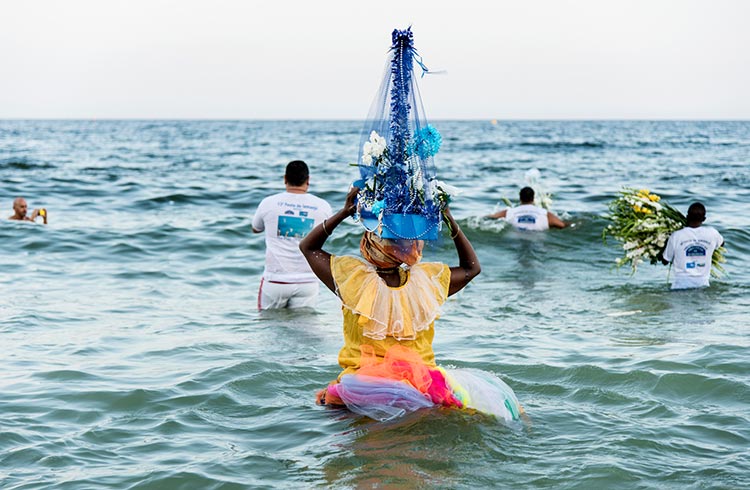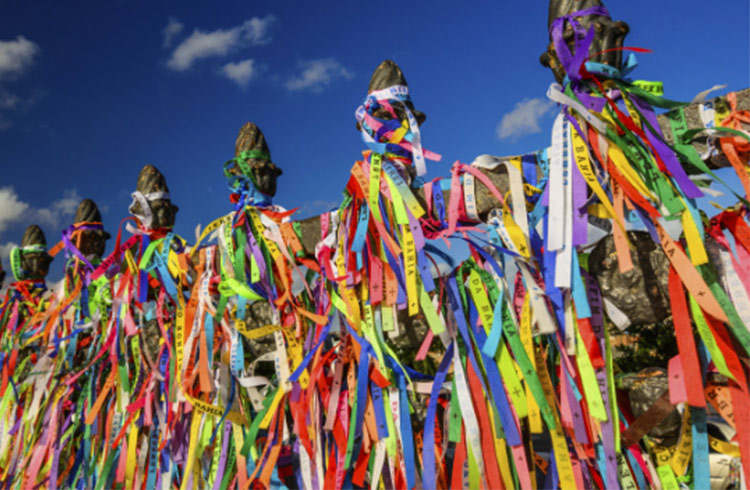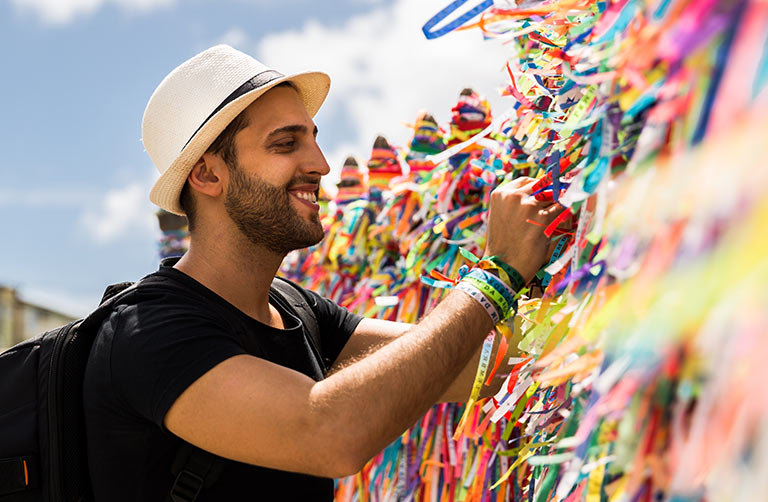How to Experience the Festivals of Candomblé in Salvador
With 2 million followers in Brazil, Candomblé is a widely practiced religion steeped in ritual and celebration. Find out how to experience the festivities and ceremonies in its birthplace of Salvador.
Shares
 Photo © Getty Images/Ze Martinusso
Photo © Getty Images/Ze Martinusso
On the shores of the Red Beach, Candomblé believers dressed in white robes gather around sand altars covered with gardenias.
Soon enough, someone falls into a trance and starts to writhe on the beach, letting out intense, loud screams. In more familiar settings you might rush to call an ambulance.
But here, in Salvador, the epicentre of the syncretic African-based religion known as Candomblé, the worshipper convulsing on the ground is taking part in a ritual where he is possessed with the spirit of Xango, God of Fire.
- What is Candomblé?
- How is Candomblé practiced in Salvador?
- Festival of Yemanja
- Washing of Bonfim Festival
- Etiquette tips for Candomblé
What is Candomblé?
Candomblé is a composite of Portuguese Catholicism and African paganism, which can be traced back to the West African slave trade. While Candomblé is most fervently practiced in Salvador, it defines the raw, uninhibited sensuality of Brazilians that you can find all over the country.
Around 40% of all African slaves transported to the New World came to Brazil – officially 4.5 million, and that’s a conservative estimate. Millions came to Bahia, the center of Brazil's sugar and slave trades, and today more than 80% of the population has African ancestry.
African slaves believed in a pantheon of protector gods (known as Orixás) who not only personify natural forces such as fire, wind and water, but also find handy allegiance with all things animate and inanimate: animals, colors, a day of the week or a certain food group.

How is Candomblé practiced in Salvador?
Candomblé ceremonies take place on sacred ground, called terreiros, which are dotted throughout Salvador. Witnessing a ceremony is a fascinating cultural experience, where singing, chanting, hypnotic drumming, seismic convulsing and intense perfumes waft through the air. These rituals are an attempt to get on the right side of the protector gods (Orixás) and incite them to possess some of the practicioners present.
Ceremonies and religious items are themed accordingly; the house is decorated with the color of the honorary Orixá, and the god’s favorite African dish is usually served. Oxum is rather partial to black-eyed peas apparently, which are prepared by hand so that the cook’s energy can be transmitted.
If you attend a ceremony in honor of Ossaim, the Orixá of Foliage, you will be swept from head to toe in leaves. If pyrotechnics are your thing, pay homage to Xango, God of Fire, whose ceremony reaches a rather hazardous climax when bowls of fire are passed, head to head, among the worshippers.
Festival of Yemanja (Festa de Iemanja)
Held each year on February 2nd, devotees dressed in white descend to the ocean in Bahia, Salvador to decorate the area with images, light candles, perform ceremonies and give offerings to the Goddess of the Sea, Yemanja.
Yemanja is considered to be the protectress of children, fishermen and sailors. Locals prepare offerings of baskets for fishermen to take out to sea and offer to the Orixás. Believers will jump seven waves to bring good luck for the new year.
The festival has become popular over the years, attracting both locals and travelers. The streets transform into a huge party by the end of the day, with music, dancing, fireworks and food stalls.

Washing of Bonfim (Lavagem do Bonfim)
Lavagem do Bonfim is another popular Candomblé festival in Salvador, dating back to 1754. It is held each year on the second Thursday in January. A large procession flows through the city from Church of Conceicao da Praia to the Church of Bonfim featuring dance, music and food. The procession wraps up with a traditional symbolic washing of the church steps, using water infused with herbs and flowers by barefoot baianas (worshippers), dressed in white and decorated with brightly colored beads.
Festival attendees will also see traditional brightly colored ribbons (fita do Senhor do Bonhim) which are tied to the wrist or to the surrounding church fence and pray for wishes to be granted.
Other Candomblé festivals celebrated throughout the year include Day of the Samba on 1st and 2nd of December, Santa Barbara on December 4th, Our Lady of Conceicao du Praia on December 8th, and Senhor dos Navegantes Festival on New Years Eve and New Years Day which includes a maritime parade.

Etiquette tips for Candomblé
If you get the chance to observe a Candomble ceremony or festival, here are a few handy things to know:
- The language used in Candomblé is Yoruba, a West African language spoken in Nigeria. So don't stress if your Portuguese isn't quite up to scratch.
- While there are many terreiros (places of worship) in Salvador, most are located in dodgier neighborhoods beyond the limits of downtown.
- Dress appropriately by covering up and avoiding skimpy outfits. White clothing is preferred.
- No video or photography is allowed during ceremonies.
- Visitors cannot participate in the ceremony, only observe.
- Follow the crowd, if everyone else stands, you stand too.
- Before you tuck into the food or join the wild dancing, remember that these practices are part of the ceremony and are reserved for devotees.
- Real terreiros (places of worship) generally won't quote an admission price, but they will certainly appreciate a donation for the Mãe or Pai de Santo (spiritual leader) of the terreiro.
You can get the address and time of a ceremony through Bahiatursa. This local tourist office has locations all over Salvador. It is safest to go with a local guide.
If someone approaches you with an offer to attend a Candomblé session, always research your options carefully, as some ceremonies will be more of a tourist attraction than an authentic experience. For your best shot at authenticity, Tatur Turismo is one of Salvador’s best operators.
Related articles
Simple and flexible travel insurance
You can buy at home or while traveling, and claim online from anywhere in the world. With 150+ adventure activities covered and 24/7 emergency assistance.
Get a quote
No Comments